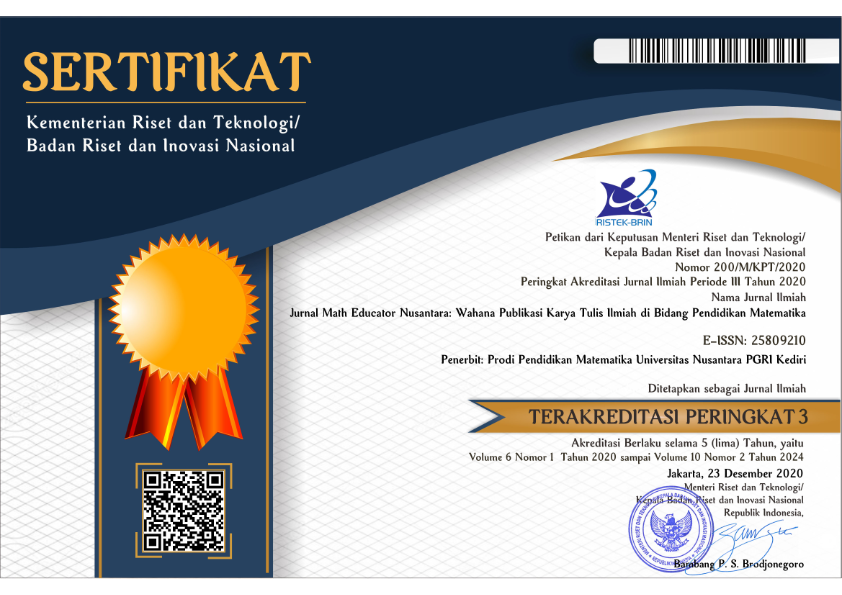Profile of creative thinking skills in solving math problems on reflective and impulsive cognitive forces
DOI:
https://doi.org/10.29407/jmen.v7i1.15845Keywords:
Creative thinking skills, Cognitive style, Reflective, ImpulsiveAbstract
This study aims to describe the profile of students' mathematical creative thinking ability in solving math problems of material circles students on with reflective and impulsive cognitive styles. This type of research is qualitative descriptive research. The subjects taken were 2 grade VIII students at one of the Madrasah Tsanawiyah in Magelang even semester of the 2020/2021 school year, each of which was cognitively reflective and cognitively impulsive. Data collection is used with MFFT test, mathematical creative thinking test and interview. Data analysis techniques are carried out in 3 stages, namely data reduction, data presentation, conclusion drawing. The technique of checking the validity of data using triangulation method is to compare the results of the test understanding mathematical concepts with the results of interviews. The analysis was developed based on indicators of creative thinking by paying attention to the cognitive style. Based on the results of the analysis, it is known that subjects with reflective cognitive styles have a category of TKBK 3 which means creative because it is able to meet only 2 indicators of fluency and flexibility. Subjects with impulsive cognitive style have a category of TKBK 1 which means less creative because the subject only meets 1 indicator, namely fluency.
References
Artikasari, E. A., & Saefudin, A. A. (2017). Menumbuh Kembangkan Kemampuan Berpikir Kreatif Matematis Dengan Pendekatan Contextual Teaching And Learning: mathematic creative thinking, contextual teaching and learning approach. Jurnal Math Educator Nusantara: Wahana Publikasi Karya Tulis Ilmiah Di Bidang Pendidikan Matematika, 3(2), 73-82. https://doi.org/10.29407/jmen.v3i2.800
Fadiana, M. (2016). Perbedaan Kemampuan Menyelesaikan Soal Cerita antara Siswa Bergaya Kognitif Reflektif dan Impulsif. JRAMathEdu (Journal of Research and Advances in Mathematics Education), 1(1), 79–89. https://doi.org/10.23917/jramathedu.v1i1.1775
Fauzi, A. (2004). Psikologi Umum. Bandung: CV Pustaka Setia
https://doi.org/10.24176/jkg.v2i1.561
Kagan, J. (1965). Impulsif dan Reflektif children: significance of conceptual tempo. Rand McNally and Company.
Miatun, A., & Nurafni, N. (2019). Profil kemampuan berpikir kreatif matematis ditinjau dari gaya kognitif reflective dan impulsive. Jurnal Riset Pendidikan Matematika, 6(2), 150–164. https://doi.org/10.21831/jrpm.v6i2.26094
Muliawati, N. E., & Istianah, N. F. (2017). Proses Berpikir Kreatif Siswa Dalam Memecahkan Masalah Matematika Ditinjau Dari Gaya Kognitif. JP2M (Jurnal Pendidikan Dan Pembelajaran Matematika), 3(2), 118. https://doi.org/10.29100/jp2m.v3i2.1768
Nengsih, L. W., Susiswo, & Sa’dijah, C. (2019). Kemampuan Pemecahan Masalah Matematika Siswa Sekolah Dasar dengan Gaya Kognitif Field Dependent. Jurnal Pendidikan: Teori, Penelitian, Dan Pengembangan, 4(2), 143–148. https://doi.org/10.17509/eh.v3i2.2807
Ningsih, P. R. (2012). Profil berpikir kritis siswa smp dalam menyelesaikan masalah matematika berdasarkan gaya kognitif. Gamatika, 2.
Purnomo, D. J., M Asikin, & Junaedi, I. (2015). Tingkat Berpikir Kreatif Pada Geometri Siswa Kelas VII Ditinjau Dari Gaya Kognitif Dalam Setting Problem Based Learning. Unnes Journal of Mathematics Education, 4(2). https://doi.org/10.15294/ujme.v4i2.7450
Puspitasari, L., In’am, A., & Syaifuddin, M. (2018). Analysis of Students’ Creative Thinking in Solving Arithmetic Problems. International Electronic Journal of Mathematics Education, 14(1), 49–60. https://doi.org/10.12973/iejme/3962
Rahmatina, S., Sumarmo, U., & Johar, R. (2014). Tingkat Berpikir Kreatif Siswa dalam Menyelesaikan Masalah Matematika Berdasarkan Gaya Kognitif Reflektif dan Impulsif. Jurnal Didaktik Matematika, 1(1), 62–70. https://doi.org/10.24815/jdm.v1i1.1242
Rahmazatullaili, R., Zubainur, C. M., & Munzir, S. (2017). Kemampuan berpikir kreatif dan pemecahan masalah siswa melalui penerapan model project based learning. Beta Jurnal Tadris Matematika, 10(2), 166–183. https://doi.org/10.20414/betajtm.v10i2.104
Silver, E. A. (1997). Fostering creativity through instruction rich in mathematical problem solving and problem posing. ZDM. https://doi.org/10.1007/s11858-997-0003-x
Siswono, T. Y. (2008). Model pembelajaran Matematika Berbasis Pengajuan dan Pemecahan Masalah Untuk Meningkatkan Kemampuan Berfikir Kreatif. Surabaya: Unesa University Press.
Siswono, T. Y. E. (2016). Berpikir Kritis dan Berpikir Kreatif sebagai Fokus Pembelajaran Matematika. Jurnal Pendidikan FPMIPA PGRI Semarang, 11–26.
Sudia, M., & Lambertus, L. (2017). Profile of high school student mathematical reasoning to solve the problem mathematical viewed from cognitive style. International Journal of Education and Research, 5(6), 163–174. https://www.ijern.com/journal/2017/June-2017/14.pdf
Ulya, H. (2016). Profil Kemampuan Pemecahan Masalah Siswa Bermotivasi Belajar Tinggi Berdasarkan Ideal Problem Solving. Jurnal Konseling Gusjigang, 2(1), 90–96.
Warli. (2010). Pembelajaran Kooperatif Berbasis Gaya Kognitif Reflektif-Impulsif (Studi Pendahuluan Pengembangan Model KBR-I). Prosiding Seminar Nasional Penelitian, Pendidikan Dan Penerapan MIPA, M–567, 567–574.
Wulandari, R. (2017). Analisis Gaya Kognitif Siswa Dalam Pemecahan Masalah. Jurnal Widyagogik, 4(2), 95–106.
Downloads
Published
Issue
Section
License
Authors who publish with this journal agree to the following terms:
- Copyright on any article is retained by the author(s).
- The author grants the journal, the right of first publication with the work simultaneously licensed under a Creative Commons Attribution License that allows others to share the work with an acknowledgment of the work’s authorship and initial publication in this journal.
- Authors are able to enter into separate, additional contractual arrangements for the non-exclusive distribution of the journal’s published version of the work (e.g., post it to an institutional repository or publish it in a book), with an acknowledgment of its initial publication in this journal.
- Authors are permitted and encouraged to post their work online (e.g., in institutional repositories or on their website) prior to and during the submission process, as it can lead to productive exchanges, as well as earlier and greater citation of published work.
- The article and any associated published material is distributed under the Creative Commons Attribution-ShareAlike 4.0 International License














